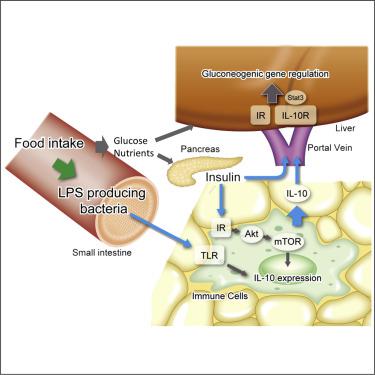Molecular Cell ( IF 14.5 ) Pub Date : 2020-05-27 , DOI: 10.1016/j.molcel.2020.04.033 Gotaro Toda 1 , Kotaro Soeda 1 , Yukiko Okazaki 1 , Naoki Kobayashi 2 , Yukari Masuda 3 , Naoko Arakawa 1 , Hirotsugu Suwanai 3 , Yosuke Masamoto 4 , Yoshihiko Izumida 3 , Nozomu Kamei 3 , Takayoshi Sasako 3 , Ryo Suzuki 3 , Tetsuya Kubota 3 , Naoto Kubota 3 , Mineo Kurokawa 4 , Kazuyuki Tobe 5 , Tetsuo Noda 6 , Kenya Honda 7 , Domenico Accili 8 , Toshimasa Yamauchi 3 , Takashi Kadowaki 9 , Kohjiro Ueki 1

|
The physiological role of immune cells in the regulation of postprandial glucose metabolism has not been fully elucidated. We have found that adipose tissue macrophages produce interleukin-10 (IL-10) upon feeding, which suppresses hepatic glucose production in cooperation with insulin. Both elevated insulin and gut-microbiome-derived lipopolysaccharide in response to feeding are required for IL-10 production via the Akt/mammalian target of rapamycin (mTOR) pathway. Indeed, myeloid-specific knockout of the insulin receptor or bone marrow transplantation of mutant TLR4 marrow cells results in increased expression of gluconeogenic genes and impaired glucose tolerance. Furthermore, myeloid-specific Akt1 and Akt2 knockout results in similar phenotypes that are rescued by additional knockout of TSC2, an inhibitor of mTOR. In obesity, IL-10 production is impaired due to insulin resistance in macrophages, whereas adenovirus-mediated expression of IL-10 ameliorates postprandial hyperglycemia. Thus, the orchestrated response of the endogenous hormone and gut environment to feeding is a key regulator of postprandial glycemia.
中文翻译:

脂肪组织巨噬细胞中胰岛素和脂多糖介导的信号通过 Akt-mTOR 激活调节餐后血糖。
免疫细胞在调节餐后葡萄糖代谢中的生理作用尚未完全阐明。我们发现,脂肪组织巨噬细胞在进食时会产生白细胞介素 10 (IL-10),它与胰岛素配合抑制肝葡萄糖的产生。通过 Akt/哺乳动物雷帕霉素靶点 (mTOR) 途径产生 IL-10 需要响应进食而升高的胰岛素和肠道微生物组衍生的脂多糖。事实上,胰岛素受体的骨髓特异性敲除或突变型 TLR4 骨髓细胞的骨髓移植会导致糖异生基因表达增加和糖耐量受损。此外,骨髓特异性 Akt1 和 Akt2 敲除会导致相似的表型,而通过额外敲除 mTOR 抑制剂 TSC2 可以挽救这些相似的表型。在肥胖症中,巨噬细胞中的胰岛素抵抗导致 IL-10 的产生受损,而腺病毒介导的 IL-10 表达可改善餐后高血糖。因此,内源激素和肠道环境对进食的协调反应是餐后血糖的关键调节因子。











































 京公网安备 11010802027423号
京公网安备 11010802027423号